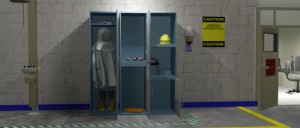Roughly 20% of the electricity produced in the United States every year is used to power industrial facilities and equipment. While electricity makes it possible for these facilities to operate, it also poses a very real hazard, with several hundred electricity-related fatalities occurring at the workplace every year. In order to avoid or treat electrical shock, one has to first understand it.
There are three ways a person can experience an electric shock. A person may come in contact with energized conductors in a circuit. A person may provide a path between an ungrounded energized conductor and a neutral conductor, or a person may provide a path between an energized conductor and ground.

The severity of an electric shock depends on three factors.
- The amount of current conducted through the body.
- The path of the current through the body.
- The length of time a person is subjected to the current.
Imagine, a co-worker is performing maintenance on a motor controller, when they suddenly begin having full-body muscular contractions. It looks like they’re holding onto an electrical wire. The correct emergency response actions, performed quickly, can save this person’s life.
Send for Help – Send for professional medical help as soon as possible. Even if the victim is conscious and appears to be fine, medical attention is required.
Remove the Source of Electricity – If the victim is still in contact with the current, remove power from the circuit by opening the breaker, pressing an emergency stop switch, or by any other means available. If the power supply cannot be shut off, pry the person away with something nonconductive, like a shepherd’s hook, a piece of wood, a broom handle, or a plastic pipe.
Time is Vital – Immediate help is essential for victims of electrical shock. There is a 90% chance of surviving ventricular fibrillation caused by shock if treatment begins within 1 minute. Those chances fall to 50% if treatment starts at two minutes. After three minutes, the chance of surviving falls to nearly zero.
Check Vital Signs – Feel or listen at the victim’s mouth and nose for indications of breathing. Feel below the ribs and over the diaphragm for a heartbeat. Check for a pulse at the neck or wrist.
CPR – If necessary and qualified, begin cardiopulmonary resuscitation, or CPR, and continue it until medical help arrives. Although CPR may not revive the victim, it will maintain a flow of oxygen to the brain, greatly improving their chance of survival.
Automatic External Defibrillator (AED) – Automatic external defibrillators, or AEDs, are portable devices that automatically diagnose and treat potentially life-threatening cardiac arrhythmias. Many facilities will have at least one AED and will train employees how to use one in their basic first aid or CPR course.

